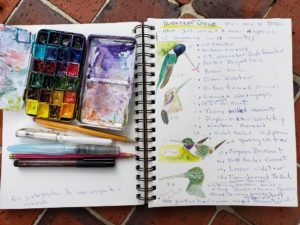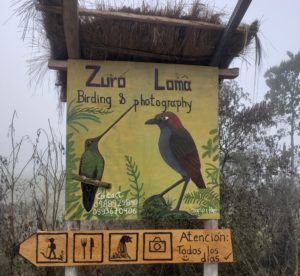Tales of Birdwatching and Sketching on the Equator
Tandayapa Bird Lodge Review 2020
I had the pleasure of staying at Tandayapa Bird Lodge for almost two weeks to enjoy some much-needed peaceful solitude. As its name suggests, there are many species of birds to observe since the lodge property is surrounded by lush, virgin cloud forests.
They are famous for the number of hummingbird species they host. In fact I observed over 20 species in my first day at the lodge including the following creatively named species:
White-necked Jacobin, Andean Emerald, Western Emerald, Purple-throated Woodstar, Brown Inca, Brown Violetear, Sparkling Violetear, Lesser Violetear, Crowned Woodnymph, Green Crowned Brilliant, Empress Brilliant, Fawn-breasted Brilliant, Tawny-bellied Hermit, Purple-bibbed Whitetip, Violet-tailed Sylph, Booted Racket-tail, Buff-tailed Coronet, and Rufous-tailed Hummingbirds.
The lodge itself is warm and cozy, and I was made to feel perfectly at home by the kind and proficient staff. Meals were healthy and hearty, topped off by desserts served at both lunch and breakfast!
The lodge has a nice loop trail with a waterfall and one can spot many species of birds during a forest hike including iconic toucans, parrots, and the Andean Cock of the Rock.
There is a ‘moth light’ illuminated at night that attracts really cool insects and in the morning one can watch insectivorous birds like Toucan Barbets taking advantage of it to fill up on breakfast.
The staff also keeps the fruit feeders full, which attract the likes of Rufous Motmots, Crimson-rumped Toucanets, and squirrels. I was lucky to see the rare, nocturnal Olinguito, a mammal species only recently discovered and described by science, who was visiting the feeders and noshing down on bananas!
The lodge is situated in an ideal corner of Ecuador for birdwatching, with many well-known sites and trails within a couple hours’ drive of the lodge.
I highly recommend Tandayapa Bird Lodge and will certainly return as soon as I’m able!

Hummers of Tandayapa Bird Lodge
Arriving at Tandayapa Bird Lodge after the 90-minute drive from the Quito airport, we were raucously greeted by a pair of Crimson-rumped Toucanets perched in a tree above the parking area.
Ascending the stairway leading to our rooms, we were immediately drawn to the deck and the famous hummingbird feeders, and they didn’t disappoint. Who’s got time to unpack luggage when Booted Racket-tails and Crowned Woodnymphs are beckoning?
Each of the nectar tubes are lettered from A-E to facilitate identifying which feeder is hosting which of the myriad hummers.
The bird’s multi-syllabled names perfectly describe the iridescent colors of their heads, throats, breasts, and tails.
White-necked Jacobin, Andean Emerald, Western Emerald, Purple-throated Woodstar, Brown Inca, Brown Violetear, Sparkling Violetear, Lesser Violetear, Crowned Woodnymph, Green Crowned Brilliant, Empress Brilliant, Fawn-breasted Brilliant, Tawny-bellied Hermit, Purple-bibbed Whitetip, Violet-tailed Sylph, Booted Racket-tail, Buff-tailed Coronet, and Rufous-tailed Hummingbirds.
I brandished my journal and paints and set about the impossible task of making quick field sketches of the birds, many of which were ‘lifers’ for me.

Learn more about Tandayapa Bird Lodge.
Yanacocha Reserve
Today’s Ecuadorian adventure was at Yanacocha Reserve, a project of the Jocotoco Conservation Foundation.
I accompanied Sam Woods, of Tropical Birding Tours, to this pristine cloud forest habitat where we started the day observing the hummingbird feeders that attracted such stunners as the Golden-breasted Puffleg, Buff-winged Starfrontlet, Tyrian Metaltail, and the Great Sapphirewing; the 2nd largest of all ~360 hummingbird species.
Next, we hiked into the reserve along the ‘Trocha Inca’ or Inca Trail, that gave us fabulous views of the steep slopes of the virgin cloud forest; home to Spectacled Bears and Pumas.
Along the way, we were treated to some very special birds including Rufous Antpitta, Tawny Antpitta, Gray-browed Brushfinch, Rufous Wren, Ash-colored Tapaculo, as well as Masked and Glossy Flowerpiercers.
We heard the call of a Superciliaried Hemispingus (that’s a mouthful!) and some formidable drums of a distant Powerful Woodpecker.
The hike’s highlight was a pair of Ocellated Tapaculos; skulky birds of the dense underbrush whose plumage sports a breast covered in bright white spots against a background of black feathers.
After we chased the sounds of a pair of hooting White-throated Screech Owls far down a steep trail and hiked briskly back up we were winded from the elevation (3,500 meters!) and had certainly earned our lunch which was waiting for us back at the reserve’s headquarters.
Another excellent day of birdwatching in the wilds of Ecuador!
Learn more about Yanachoca.
Zuro Loma Reserve
It was a fabulous morning birding with Sam Woods of Tropical Birding Tours.
Many birds were whizzing about, taking full advantage of the many fruit and nectar feeding stations including flowerpiercers, brushfinches, Sword-billed Hummingbirds, Mountain velvetbreasts, Buff-winged Starfrontlets, Sapphire-vented Pufflegs, Collared Incas, and Tyrian Metaltails to name just a few. The highlight for me was holding a miniature feeder and having tiny hummingbirds bravely perch on my finger to steal a sips of sweet nectar!
The talented birders at the reserve have successfully trained some Chestnut-naped Antpittas to visit their feeders and we watched as these normally shy forest dwellers gobbled up some worms.
Next, we took an invigorating hike, considering the high altitude, led by local guide Dario, that started with a Black-tailed Trainbearer hummingbird perched in a tree and some Burrowing Owls making their home in the cattle pasture.
We continued up to a mirador with excellent 360-degree views of the surrounding mountain peaks and volcanoes. An American Kestrel soared lazily across the sky.
Along the way, we enjoyed excellent views of a colorful and animated Scarlet-bellied Mountain-Tanager and a foraging Crimson-mantled Woodpecker, plus Rufous Antpitta, Tufted Tit Tyrant, Red-crested Cotinga, Glossy Flowerpiercer, White-crested Elania and a Spectacled Redstart; a stunning warbler that appears to wear lemon yellow eyeglasses!.
We certainly earned our lunch once back at the feeders, where the owners grilled us a tasty lunch of fresh trout!
Learn more about Reserva Zuro Loma
Reserva Amagusa
Today I spent the day at Reserva Ecologica Mashpi-Amagusa,located a few hours’ drive northwest of Ecuador’s capital city of Quito, accompanied by Sam Woods of Tropical Birding Tours.
This region is an Important Bird Area (IBA) known as Mashpi-Pachijal. It encompasses a slice of the Choco bioregion that supports many endemics in its foothill wet forests within the larger Neotropical Cloud Forest habitat.
We started our morning with a misty walk down the entrance road accompanied by the reserve’s owner, Sergio Basantes, who has been working hard to make his property as bird-friendly and birder-friendly as possible, with multiple feeders with comfortable viewing areas, restrooms, and lunch service.
We were treated to excellent views of many special birds in the canopy including Indigo Flowerpiercer, Golden-collared Honeycreeper, Ornate Flycatcher, Uniform Antshrike, Black-chinned Mountain-Tanager, and a pair of stunning Orange-breasted Fruiteaters.
A White-tipped Sicklebill hummer was seen visiting a heliconia and a Violet-tailed Sylph dipped low to the ground to check out some red flowers.
In the distance we heard a Black Solitaire singing his melodic tune and a Toucan Barbet calling while some Bronze-winged Parrots flew over, and later some Rose-faced Parrots did the same. A Buffy (Pacific) Tuftedcheek called from a tangled mass of branches overhead.
Other treats included Orange-bellied Euphonia, Buff-throated Saltator, Bronze-olive Pygmy-Tyrant, Bay Wren, and a Crimson-rumped Toucanet.
Once we arrived at Reserva Amagusa, we were immediately treated to a feeding frenzy of tanagers. It was such a fun challenge to sketch the multiple species all vying for their spot on the fruit feeders.
Tanager species included: Moss-backed, Flame-faced, Flame (Lemon)-rumped, Golden-naped, Glistening-green, Rufous-throated, Fawn-breasted, and Blue-gray.
We enjoyed lunch on the new patio, with multiple hummer species whizzing past our ears. A Velvet-purple Coronet even landed on my head, apparently judging the accuracy of my sketch. This hummer is one of the Choco regional endemics, along with the Violet-tailed Sylph, Brown Inca, Purple-bibbed Whitetip and the aptly named Empress Brilliant.
The day all too soon flew by and so after one last sketching session to capture the silhouettes of the various hummers, we headed back to the lovely Tandayapa Bird Lodge.
Learn more about Reserva Amagusa.
Milpe Bird Sanctuary
Today I joined Sam Woods of Tropical Birding Tours to explore Milpe Bird Sanctuary, a montane evergreen forest on the western slope of the Andes mountain range near the town of San Miguel de los Bancos in northwestern, Ecuador.
Hiking the sanctuary’s trails we saw active mixed flocks that included Western Wood Haunter, Buff-fronted Foliage Gleaner, Grey-breasted Wood Wren, Russet Antshrike, Bay Wren, Three-striped Warbler, Yellow-throated Chlorospingus, Spotted Woodcreeper, Wedge-billed Woodcreeper, Slaty Antwren, Buff-rumped Warbler, Choco Trogon, Choco Warbler, Spotted Nightengale Thrush….and a few more I likely forgot to note in my sketchbook!
We followed the tapping sounds of a woodpecker and discovered a female Guayaquil Woodpecker who was industriously foraging on a tall snag in the forest.
Farther down the trail, we heard the characteristic ‘yelping’ of a Chestnut-mandibled Toucan and watched it preening in a Cecropia tree right above our heads. This species is nearly indistinguishable from the endemic Choco Toucan, who has a slightly blacker bill and makes a ‘croaking’ sound.
A Broad-billed Motmot was silently perched on a branch with only the tik-toking of its tail giving away its presence in sharp contrast to the flock of Bronze-winged Parrots that flew over!
It’s hard to choose today’s highlight but it was probably watching the mating display of male Club-winged Manakins, an endemic species of the Choco Bioregion of Ecuador and Colombia, who we admired and filmed for quite some time.
Males are brightly colored and gather together at sites called ‘leks’ to perform their dance in hopes of attracting a discerning female and winning the favor of mating with her.
In the Youtube video I filmed below, you’ll hear the unique snapping sound created by their wings when raised and lowered as part of their dance. I’ve included a slow-motion segment to help you see how this is accomplished. The Club-winged Manakin, Machaeropterus deliciosus, is just one of about 60 species in the manakin family, whose members reside in the Neotropics and each has a mating display that is unique to the species! We also heard the White-bearded Manakin at this preserve but watching its mating dance will have to wait for a future visit the Milpe Bird Sanctuary.
Watch the Dance of the Club-winged Manakin
Learn more about Milpe Bird Sanctuary.


